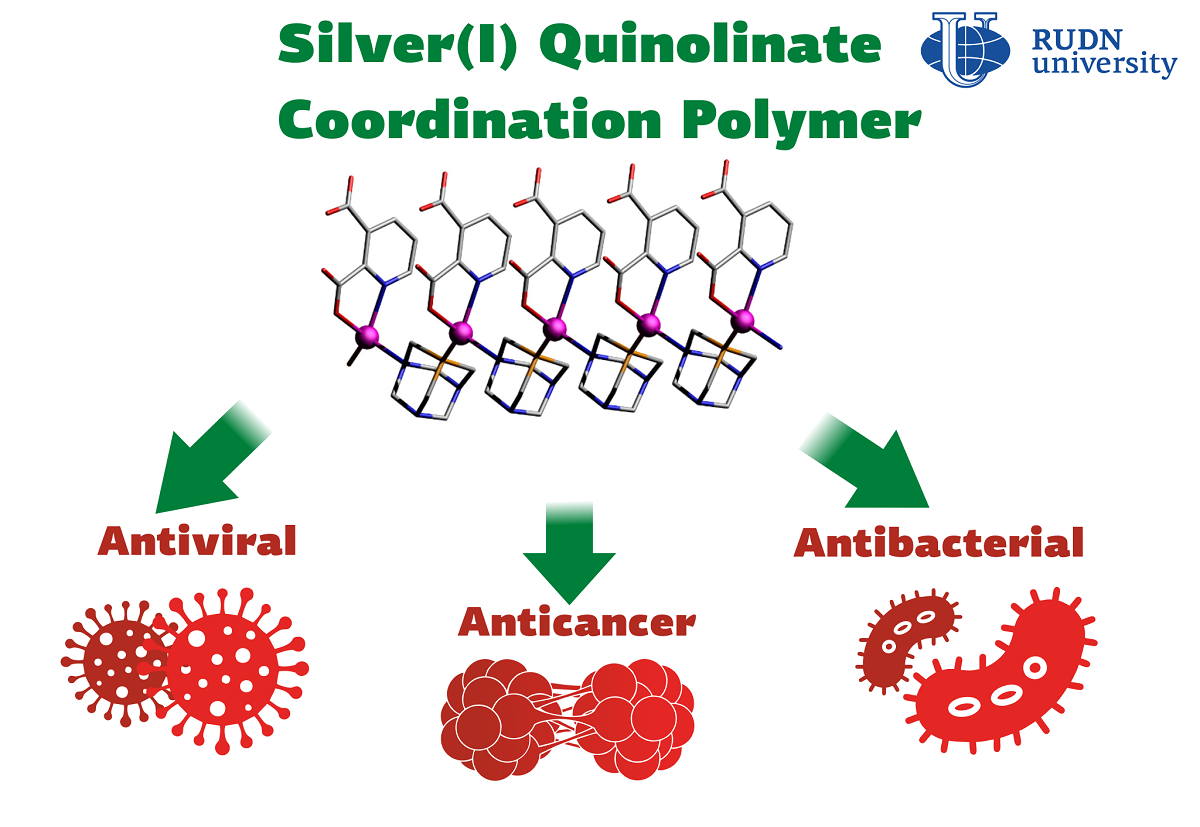RUDN chemist has created a powerful antimicrobial drug that is several times more effective than existing ones

Coordination polymers are “hybrids” in which metal centers are linked by organic ligands. They are often bioactive, so chemists are investigating how they can be used in medicine. Infectious diseases, and especially viral diseases, are the cause of most global pandemics. Viruses have killed people for centuries and contributed to the deaths of millions around the world. RUDN University chemist together with his colleagues from Poland, created a silver-based coordination polymer and proved its effectiveness in fighting bacteria and viruses, as well as in suppressing cancer cell growth.
“Combining biologically active metal ions and biorelevant organic components into an organometallic network is an attractive way to develop new bioactive materials. The new complex exhibited remarkable antiviral activity, significant antibacterial activity against clinically significant bacteria, and selective cytotoxicity against human cervical carcinoma cells,” said Alexander Kirillov, Ph.D. in Сhemistry, an Associate of the RUDN Joint Institute for Chemical Research.
Chemists have proposed a silver-based coordination polymer that is produced according to the self-assembly principle, an ordered structure is assembled from the initial elements, like parts of a jigsaw puzzle. The reaction takes place in an aqueous or methanol medium at a temperature of about 25℃. Silver oxide, quinolinic acid and water-soluble aminophosphine PTA are placed in it. RUDN chemists investigated the structure of the resulting complex by various methods, including X-ray diffraction analysis. The biological properties of the compound were studied on herpes simplex virus type I, Staphylococcus aureus, Escherichia coli, and Pseudomonas aeruginosa. In addition, chemists evaluated the ability of the new compound to kill human cervical carcinoma cells and lung cancer cells.
The new coordination polymer completely suppressed the herpesvirus. Its number decreased by more than a million times. This is two orders of magnitude greater than, for example, acyclovir (this common antiviral drug suppresses the herpesvirus by four orders of magnitude, that is, it reduces its number ten thousand times). The antibacterial action of the coordinated polymer was about twice as effective as that of silver nitrate, a common bactericidal agent. The coordinating polymer also has a pronounced cytotoxic effect on cervical carcinoma cells, although it had no effect on lung cancer cells.
“The results obtained are important in terms of expanding the family of coordination polymers and contribute to the understanding of their bioactivity, as well as reveal significant potential for developing new antiviral and antimicrobial agents,” said Alexander Kirillov.
The study is published in Inorganic Chemistry.
RUDN summarized the results of the scientific competition "Project Start: work of the science club ". Students of the Faculty of Physics, Mathematics and Natural Sciences have created a project for a managed queuing system using a neural network to redistribute resources between 5G segments. How to increase flexibility, make the network fast and inexpensive and reach more users — tell Gebrial Ibram Esam Zekri ("Fundamental Computer Science and Information Technology", Master's degree, II course) and Ksenia Leontieva ("Applied Mathematics and Computer Science", Master's degree, I course).
The National Demographic Report, 2023 Demographic Well-Being of Russian Regions (hereinafter - the National Demographic Report) was prepared by the scientific team of the Institute of Demographic Studies of the Federal Research Center of the Russian Academy of Sciences, the Vologda Scientific Center of the Russian Academy of Sciences, Peoples' Friendship University of Russia, the Center for Family and Demography of the Academy of Sciences of the Republic of Tatarstan, as well as with the participation of leading scientists from the Republic of Bashkortostan, Stavropol Krai, Volgograd, Ivanovo, Kaliningrad, Nizhny Novgorod, Sverdlovsk Oblasts and Khanty-Mansi Autonomous Okrug–Yugra.
RUDN summarized the results of the scientific competition "Project Start: work of the science club ". Students of the Faculty of Physics, Mathematics and Natural Sciences have created a project for a managed queuing system using a neural network to redistribute resources between 5G segments. How to increase flexibility, make the network fast and inexpensive and reach more users — tell Gebrial Ibram Esam Zekri ("Fundamental Computer Science and Information Technology", Master's degree, II course) and Ksenia Leontieva ("Applied Mathematics and Computer Science", Master's degree, I course).
What is your first association with the word “laboratory”? Flasks and beakers? Microscopes and centrifuges? Yes, many of us would answer the same way.
The National Demographic Report, 2023 Demographic Well-Being of Russian Regions (hereinafter - the National Demographic Report) was prepared by the scientific team of the Institute of Demographic Studies of the Federal Research Center of the Russian Academy of Sciences, the Vologda Scientific Center of the Russian Academy of Sciences, Peoples' Friendship University of Russia, the Center for Family and Demography of the Academy of Sciences of the Republic of Tatarstan, as well as with the participation of leading scientists from the Republic of Bashkortostan, Stavropol Krai, Volgograd, Ivanovo, Kaliningrad, Nizhny Novgorod, Sverdlovsk Oblasts and Khanty-Mansi Autonomous Okrug–Yugra.